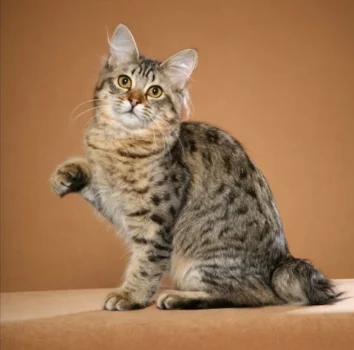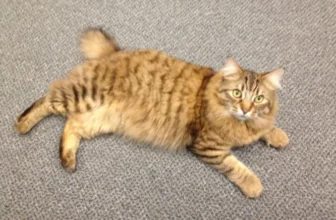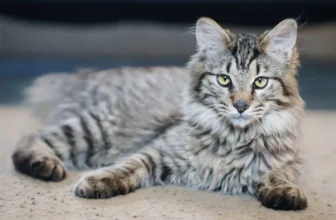The Origins of the American Bobtail
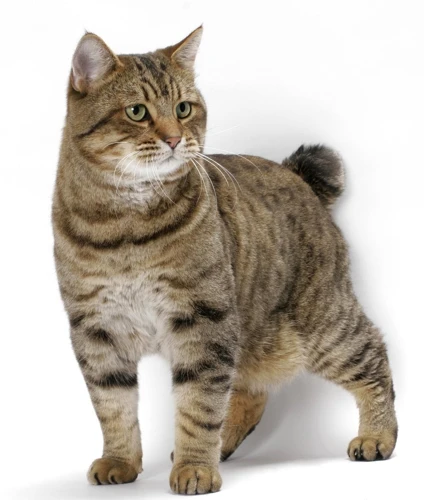
The American Bobtail is a unique breed of cat that can be traced back to the late 1960s. The origins of the American Bobtail are somewhat murky, but it is widely believed that the breed resulted from natural genetic mutations. According to some sources, the American Bobtail may have originated from a cross between a domestic cat and a wild Lynx rufus, or bobcat, though there is little concrete evidence to support this theory.
It is believed that the first American Bobtail appeared in Arizona in the late 1960s. A young couple named John and Brenda Sanders found a short-tailed brown tabby that they took in as a pet. They soon discovered that this cat was unlike any other they had seen before – not only did it have a shortened tail, but it also had a wild, untamed look and an assertive personality. They named the cat Yodie and began breeding her with other cats to produce kittens with similar characteristics.
Despite the lack of evidence connecting American Bobtails to the wild bobcat, it is widely believed that this breed’s distinct physical and personality traits are a result of natural genetics mutations. Unlike other breeds that have been selectively bred for specific traits over generations, the American Bobtail’s distinctive characteristics have emerged naturally through a chance occurrence of genetic mutations.
Despite their unique appearance, American Bobtails share many similarities with other breeds. They are generally medium to large cats, weighing between 7 and 16 pounds. Their coats come in a wide range of colors and patterns, and they are known for their distinctive “bobbed” tails, which are typically between 1/3 and 1/2 the length of a normal cat’s tail.
While the American Bobtail’s origins are shrouded in mystery, there is no denying the significant impact this breed has had on the world of cats. From their distinctive physical features to their bold, confident personalities, American Bobtails are a breed unlike any other.
For more information on the history and evolution of the American Bobtail breed, check out our article: American Bobtail Breed Standard Evolution.
Early Breeding Efforts: The Hunt for the Ideal Bobtail
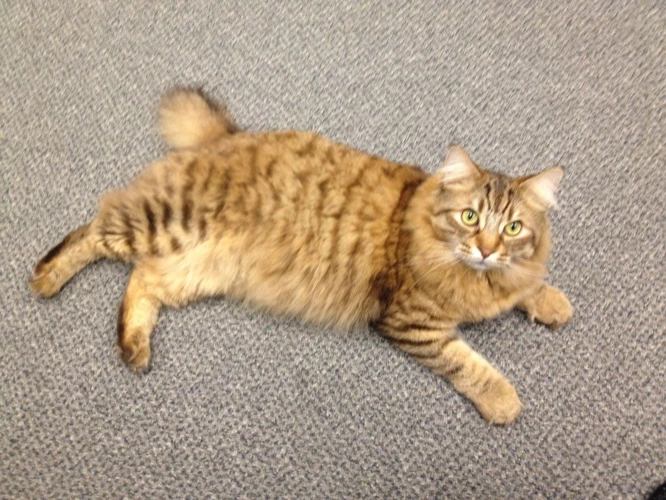
As the popularity of the American Bobtail began to rise, breeders set out on a quest for the ideal bobtail. The breeding process was an arduous journey, with challenges and obstacles to overcome. Breeding a new breed is never an easy task, and early efforts to develop the American Bobtail were no exception. Through careful planning, experimentation, and a bit of luck, dedicated breeders eventually succeeded in creating this unique breed. Let’s explore some of the key factors that were involved in the creation of the American Bobtail.
First Steps Toward a New Breed
The first steps towards developing a new breed of cats with a bobtail began in the 1960s. A couple in Iowa, John and Brenda Sanders, found a short-tailed brown tabby kitten wandering around their farm. They named the kitten Yodi and crossed it with a seal point Siamese. This was the beginning of the American Bobtail breed.
Bobtail vs Short Tails
It is important to note that the American Bobtail breed is not the same as a short-tailed cat. While short-tailed cats can have any number of tail lengths, the American Bobtail breed has a specific standard for tail length and shape. The bobtail should be about 1/3 to 1/2 of the length of a regular cat’s tail and have a “bunny-like” appearance.
Challenges of American Bobtail Breeding
Creating a new breed is not an easy task, and the Sanders faced many challenges along the way. One of the biggest challenges was establishing a breed standard that other breeders could follow. They worked with other early American Bobtail breeders to develop the ideal characteristics for the breed, including temperament, coat type, and body shape.
Key Figures in American Bobtail Breeding
John and Brenda Sanders are considered the founders of the American Bobtail breed, but other breeders played an important role in its early development. Breeders like Mindy Shultz and Charlotte Bentley helped to establish the breed standard, and their cats were integral in developing the initial breeding lines that would become the American Bobtail.
Genetic Testing in American Bobtail Breeding
As with any breeding program, genetic testing is essential to ensure the health of the breed. Breeders use genetic testing to screen for potential health problems and to ensure that kittens are not carriers of debilitating genetic conditions. Some genetic diseases that American Bobtails can be prone to include hypertrophic cardiomyopathy, feline leukemia virus, and kidney disease.
The first steps that led to the development of the American Bobtail breed were taken by John and Brenda Sanders when they crossed Yodi with a Siamese. The Sanders faced many challenges in their efforts to establish a breed standard, but with the help of other key figures in American Bobtail breeding, they were able to successfully create a breed that is now recognized and loved by cat enthusiasts worldwide. Genetic testing continues to be an important aspect of American Bobtail breeding to ensure the health of the breed in the future.
The Importance of Hybridization
When it comes to breeding any new cat breed, it can be a challenging task to find the perfect traits that cat lovers desire. One way of achieving this is through a process called hybridization. Strong and healthy kittens often come from cats with diverse genes. This cross-breeding technique involves mating cats of different breeds to produce a new breed with the desired traits. Hybridizing the bobcat with the domestic cat played an essential role in the development of the American Bobtail breed.
Hybridization allowed for:
- The cats to develop robust health, strength, and rugged characteristics.
- Developing the American Bobtail’s wild appearance, similar to that of a bobcat.
- Maintaining the domestic cat’s docile and affectionate temperament.
The people who were part of the early stages of American Bobtail breeding recognized the value of hybridization. Through this process, they were able to crossbreed natural bobtail cats with the Manx and Siamese cats, among others, to achieve their desired traits. However, it is crucial to note that not all hybridization methods can be successful. Breeding any cat breed requires careful planning, genetic testing, and a general understanding of feline genetics to produce healthy cats with predictable temperaments.
Genetic testing is essential in hybridization as it helps with:
- The identification of genetic disorders that may be inherited by the offspring.
- The identification of cats with desirable traits to help create a better breeding plan.
- Preventing the breeding of bobtails that carry two copies of the Manx gene that can cause severe fatal spinal deformities in cats.
The importance of responsible breeding practices also cannot be overstated. As breeders work towards perfecting each breed, they must ensure that they prioritize the cats’ health and welfare. Crossbreeding practices must be humane and in no way harmful to the breeds.
Hybridization was vital to the development of the American Bobtail breed. It played a major role in maintaining the breed’s desired characteristics and developing a unique, healthy breed. As the breed continues to evolve and gain popularity, breeders must continue to prioritize healthy and responsible breeding practices.
The First American Bobtail Cat
The first American Bobtail cat was discovered by John and Brenda Sanders in the late 1960s. While traveling through the southwest region of the United States, they came across a short-tailed kitten who had a remarkable appearance. They took the kitten in and named her “Yodi”. Yodi had a short, bobbed tail and a sturdy physique, which set her apart from other breed of cats.
The Sanders became fascinated with Yodi’s unique breed and decided to explore her lineage. They discovered that the cat was a product of natural selection, coming from a wild breeding of a bobcat and a domestic cat. Yodi’s littermates had different tail lengths, adding to the possibility of her hybrid origin.
Through selective breeding and genetic testing, the Sanders were able to establish the American Bobtail breed. The primary goal was to maintain Yodi’s natural beauty and physical strength, while developing a breed that was friendly and affectionate towards humans.
Today, the American Bobtail breed is recognized by both The International Cat Association (TICA) and the Cat Fanciers’ Association (CFA). Despite its wildcat ancestry, the breed has become a beloved companion animal, renowned for its intelligence, playfulness, and loyalty.
However, the breeding process was not without its challenges. The Sanders faced difficulties in maintaining the physical traits of the American Bobtail breed, while also ensuring the cat’s overall health and well-being. They faced criticism from some who believed that crossbreeding was unethical. But despite these challenges, the Sanders persevered, and the American Bobtail breed has become a success story in the world of cat breeding.
To this day, the American Bobtail remains a unique and desirable breed, with a distinct appearance and friendly disposition. It is a testament to the dedication and hard work of the Sanders, who embarked on a journey to create a new breed of cat and achieved success beyond their wildest dreams.
[Internal link: To learn more about the key figures in American Bobtail breeding, click here.](/key-figures-american-bobtail-breeding/)A New Breed Is Born: The Early Years of the American Bobtail
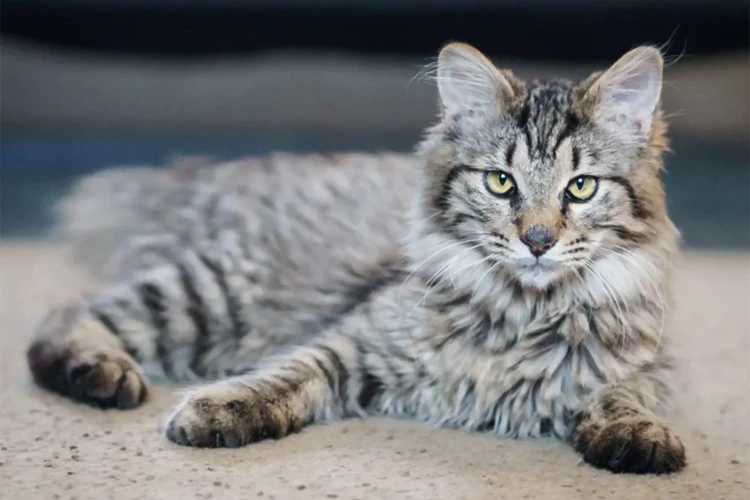
As the American Bobtail breed began taking shape, breeders faced a number of challenges and tough decisions. From selecting the right cats to breed, to establishing breed standards, the early years of the American Bobtail were filled with uncertainty and experimentation. However, despite the difficulties, a group of dedicated breeders persevered and successfully created a new breed that would become cherished by cat lovers around the world. In this section, we’ll take a closer look at the early years of the American Bobtail and the challenges that breeders faced in creating this unique breed. You can also read about some of the differences between the American Bobtail and other short-tailed breeds in our article “Bobtail vs. Short Tails: What’s the Difference?”.
CFA Recognition and Beyond
The American Bobtail gained recognition from the Cat Fanciers’ Association (CFA) in 2000, which was a significant milestone for the breed. This recognition allowed the American Bobtail to participate in CFA shows and gain even more exposure to potential breeders and pet owners. The CFA recognition also served as an acknowledgment of the breed’s unique qualities and characteristics, further solidifying its position as a distinct breed.
Beyond the recognition from the CFA, the American Bobtail also gained increasing popularity among cat enthusiasts and breeders. This growing demand led to the creation of more breeding programs aimed at producing healthy and excellent specimens of the breed. However, the breeding of American Bobtails also posed challenges, particularly in terms of maintaining genetic diversity and avoiding inbreeding. Breeding challenges for the American Bobtail can be read here.
To address these challenges, genetic testing became a critical aspect of American Bobtail breeding. By testing for various genetic disorders and traits, breeders can avoid producing kittens with health issues and undesirable traits. Genetic testing for American Bobtail breeding is discussed in detail here.
Along with the breed’s distinct physical features, its temperament also contributed to its growing popularity. American Bobtails are known for their friendly, social, and adaptable nature. Their ability to get along with people and other pets makes them an excellent choice for families or anyone looking for a loyal companion. You can read more about the American Bobtail’s temperament here.
The CFA recognition boosted the American Bobtail’s popularity, leading to more breeding programs and increased demand. As with many breeds, breeding challenges arise, and genetic testing became a crucial tool to address these challenges. Additionally, the American Bobtail’s friendly and social temperament makes it an ideal pet for many households.
Early Challenges and Triumphs
When the American Bobtail was first introduced as a breed, there were many challenges that early breeders had to face. However, with perseverance and dedication, they were able to overcome these challenges and achieve major triumphs.
One of the biggest challenges faced by American Bobtail breeders was establishing and maintaining a consistent physical standard for the breed. Strong debates arose about what features were essential and what features could be allowed to vary. Some breeders favored a certain length of tail, while others placed more emphasis on head shape and ear size. Despite these differences, over time, breeders were able to develop a standard that was more universally accepted.
Another major hurdle for American Bobtail breeders was gaining recognition from cat associations. Initially, the breed was not recognized by many organizations, including the CFA (Cat Fanciers’ Association). However, with persistent efforts from breeders and enthusiasts, the American Bobtail was eventually granted recognition in 2000.
Some early triumphs for the American Bobtail breed include the establishment of the first breed registry in 1989, as well as the creation of the International Cat Association’s (TICA) American Bobtail breed standard in 1998.
Despite these achievements, American Bobtail breeders also faced setbacks. In the early years of the breed, some kittens were born with genetic issues that prevented them from developing properly. This led to a high number of cats being born with physical deformities, which required breeders to adjust their breeding practices.
The early years of American Bobtail breeding were marked by both challenges and triumphs. Breeders had to navigate tough decisions about which physical characteristics were important, while also addressing genetic issues in the breed. Despite these setbacks, they were able to gain recognition and create a breed standard that is still admired today.
| Challenges | Triumphs |
|---|---|
| Debates over physical standard | The establishment of the first breed registry in 1989 |
| Lack of recognition from organizations | Recognition of the breed by the CFA in 2000 |
| Genetic issues leading to physical deformities | The creation of the TICA American Bobtail breed standard in 1998 |
The American Bobtail Gains Popularity
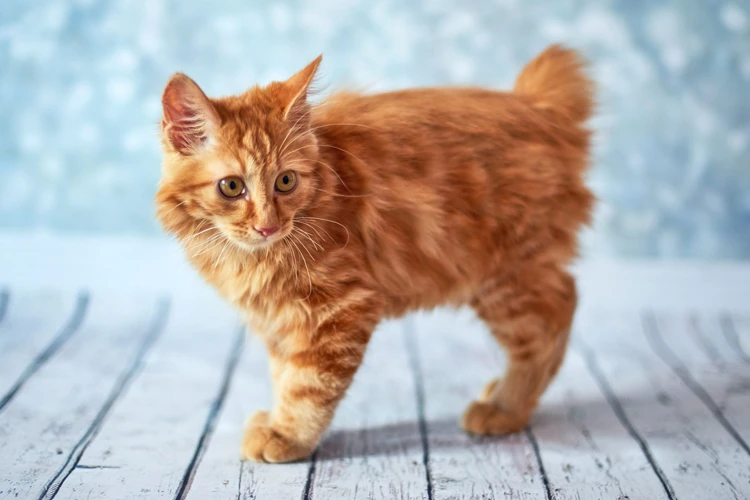
As the American Bobtail came into its own as a distinct breed, its unique and playful personality along with its eye-catching appearance began to gain considerable attention. The breed’s rise in popularity was not simply due to its charming traits, but also to the growing trend of cat owners seeking out more unique and lesser-known breeds. In this section, we will explore how the American Bobtail’s popularity grew and how it became a beloved breed among cat lovers.
The Growing Demand for Unique Breeds
The rising demand for unique cat breeds has paved the way for the American Bobtail’s popularity. Their distinct appearance and friendly demeanor have captivated cat lovers around the world. Interestingly, American Bobtails are born with a bobtail, making them an even more sought-after breed.
Here are some reasons why the demand for unique cat breeds is increasing:
- Cat owners want to stand out from the crowd and have a cat that looks different from their neighbors.
- Some owners prefer cats that are hypoallergenic, meaning they produce fewer allergens than other breeds.
- Many people are drawn to breeds with rare or unusual physical traits, such as the American Bobtail’s bobtail.
- With the advent of social media, people enjoy sharing images of their unique pets and receiving positive feedback from friends and followers.
The American Bobtail’s popularity is also driven by their temperament:
- They are known for being friendly and affectionate, making them great family pets.
- They are playful and enjoy interactive play, which is appealing to many cat owners.
- They are relatively low-maintenance and adaptable to different living situations.
In recent years, the demand for unique cat breeds has continued to grow, and the American Bobtail has solidified its place as a beloved and sought-after breed. Their distinctive appearance and friendly disposition have captured the hearts of cat lovers everywhere. As the demand for unique breeds increases, it is likely that the American Bobtail’s popularity will only continue to rise.
Appearances in Pop Culture
The American Bobtail has made its way into pop culture over the years. From TV shows to commercials, this breed has become a beloved favorite. Let’s take a closer look at some of the notable appearances in pop culture that have helped to bring attention to this unique breed:
| Show/Commercial | Description |
|---|---|
| Shaun the Sheep Movie (2015) | The American Bobtail is featured as the main villain, Trumper, in this stop-motion animated film. Trumper is a devious animal control officer who is obsessed with capturing Shaun the Sheep and his friends. |
| Rachael Ray Nutrish cat food commercials | The American Bobtail has been a frequent star in Rachael Ray’s cat food commercials. Bobtail cats are often used to promote the brand’s natural ingredients, and they bring a sense of playfulness to the ads. |
| Harry and Tonto (1974) | This classic film features a Bobtail cat named Tonto as one of the main characters. Tonto travels with his owner, Harry, on a cross-country road trip and becomes a beloved companion along the way. |
These notable appearances in pop culture have helped to showcase the American Bobtail as an endearing and unique breed. While the breed’s appearance certainly catches the eye, it is their personalities that truly make them stand out. With their playful and affectionate nature, it’s no wonder that more and more people are falling in love with this amazing breed.
The Recognition of TICA
In the early 1990s, the American Bobtail breed gained recognition from The International Cat Association (TICA). This recognition brought the breed to a wider audience and helped to solidify its place in the world of cat breeding. TICA is known for its high standards when it comes to breed recognition and American Bobtail breeders were proud to have met those standards.
TICA requirements for breed recognition:
- A minimum of 25 registered cats in the breed
- A breeding program that has been in place for at least five years
- A written breed standard that outlines the physical and personality traits of the breed
- A breed committee that is willing to work with TICA to promote the breed and meet its standards
American Bobtail breeders worked hard to meet these requirements and the recognition from TICA helped to establish the breed in the show ring. TICA recognition also meant that American Bobtails could now compete for titles and awards, further increasing the breed’s visibility.
The impact of TICA recognition:
- Increased interest in the breed
- More opportunities for American Bobtail breeders to showcase their cats
- The ability to compete for titles and awards
- Recognition from a respected international organization
Today, American Bobtails continue to be recognized by TICA and are a popular breed among cat lovers all over the world. The breed’s unique appearance and friendly, outgoing personality have made it a favorite among cat fanciers. Thanks in part to the recognition from TICA, the American Bobtail has a bright future ahead as an established and loved breed.
A Future for the American Bobtail Breed
As we look toward the future of the American Bobtail breed, there are exciting possibilities on the horizon. From the continued growth and development of the breed to the importance of responsible breeding practices, there’s much to consider for those invested in the future of this unique feline. Let’s explore some of the key factors that will shape the future of American Bobtail breeding.
The Continued Growth and Development of the Breed
As the American Bobtail breed gained popularity in the United States and around the world, its growth and development continued. Breeders worked tirelessly to improve the breed and create new variations of the beloved bobtail.
1. Crossbreeding with other breeds
One of the key strategies used to continue the growth and development of the American Bobtail has been crossbreeding with other breeds. This has not only helped to introduce new traits and characteristics to the breed but has also ensured that the gene pool remains diverse and healthy.
2. Innovation in breeding techniques
As technology and knowledge of genetics advanced, breeders were able to innovate new breeding techniques to help accelerate the growth and development of the American Bobtail breed. By using advanced techniques such as DNA testing and cloning, breeders can more accurately predict the traits and qualities of potential offspring and ensure that the breed continues to evolve in a positive direction.
3. Focus on health and temperament
While breeders work to improve the physical appearance and characteristics of the American Bobtail, the continued growth and development of the breed must also take into account the health and temperament of the cats themselves. Responsible breeders focus on creating healthy cats with good temperaments, which not only benefits the cats themselves but also helps to maintain the reputation and popularity of the breed.
4. Expansion into new geographic areas
As the popularity of the American Bobtail breed continues to grow, breeders are expanding their efforts into new geographic areas. This not only helps to introduce the breed to new audiences but can also help to develop new strains of the bobtail that may have unique characteristics based on the local environment and breeding practices.
5. Continued promotion and education about the breed
Finally, the continued growth and development of the American Bobtail breed requires ongoing promotion and education about the breed. As with any unique breed, there may be misconceptions or misunderstandings about the breed that can be remedied by educating the public about the breed’s history, characteristics, and temperament. By promoting the breed and educating the public, breeders and enthusiasts alike can ensure that the American Bobtail breed continues to thrive and evolve in the years to come.
The continued growth and development of the American Bobtail breed has been a combination of crossbreeding, innovation in breeding techniques, a focus on health and temperament, expansion into new geographic areas, and ongoing promotion and education about the breed. As the breed continues to evolve, it will be exciting to see what new variations and traits emerge in these delightful and unique cats.
The Importance of Responsible Breeding
Breeding American Bobtails requires a great deal of responsibility and care. It is essential to ensure that the breed’s health and unique characteristics are maintained for future generations. Here are some important reasons why responsible breeding matters:
- Promoting Genetic Diversity: Breeding Bobtails in a responsible manner helps to maintain their genetic diversity so that they do not become too inbred. Inbreeding can cause a range of health problems, including shortened lifespan, reduced fertility, and susceptibility to genetic diseases.
- Preventing Overpopulation: American Bobtails are still a relatively rare breed, and it is important to ensure that they do not become overpopulated. Overbreeding and careless ownership can lead to an excess of these cats, which could then increase the risk of them becoming abandoned or mistreated.
- Protecting the Breed’s Unique Characteristics: The American Bobtail’s unique physical and behavioral characteristics are what make them such a popular and beloved breed. Responsible breeding ensures that these characteristics are maintained throughout each generation, allowing the breed to retain its identity and appeal.
- Maintaining Health Standards: Breeders who prioritize responsible breeding will always prioritize the health and well-being of their cats. This includes regular veterinary check-ups, appropriate feeding and exercise routines, and proper socialization. By prioritizing these aspects, breeders can prevent potential health issues and promote overall cat welfare.
- Enhancing the Breed: Responsible breeding is important for creating healthy, happy, and desirable companions for cat lovers everywhere. It plays a pivotal role in maintaining the American Bobtail breed’s ambiance and quality, and by making sure that it is done the right way, breeders can enhance the breed’s reputation at the same time they contribute to creating a unique and distinguished breed well into the future.
By breeding Bobtails in a responsible way, we can ensure that future generations of these fascinating cats continue to exhibit the qualities and characteristics that make them so special. Responsible breeding plays an important role in promoting the overall welfare of cats and animals, contributing to the betterment of society as a whole.
Looking Ahead to the Future
As the American Bobtail breed continues to grow in popularity, there are many exciting developments to look forward to in the future. Here are some possibilities to keep an eye on:
- New Breeding Techniques: With advancements in technology and genetic testing, breeders will have more tools at their disposal to ensure the health and well-being of the American Bobtail. This could lead to the development of even stronger and healthier cat breeds.
- Increased Breed Diversity: While the American Bobtail is already a unique and distinctive breed, there is always the potential for further diversification. By selectively breeding cats with certain traits, new variations of the breed could arise.
- Advancements in Cat Behavior Research: As our understanding of cat behavior deepens, we may gain new insights into how the American Bobtail thinks and interacts with its environment. This could lead to improved training techniques and a more harmonious relationship between humans and their furry feline friends.
- Growing Popularity: As more people learn about the American Bobtail, it is likely that demand for the breed will continue to grow. This could lead to more breeders, more shows, and more opportunities to admire and appreciate these beautiful cats.
- Adaptation to New Environments: The American Bobtail is already known for its adaptability and resilience. As our climate and living conditions continue to change, it will be interesting to see how this breed responds and adapts to new challenges.
The future of the American Bobtail looks bright and exciting. Whether you are a breeder, a cat lover, or simply someone who appreciates unique and distinctive pets, there is much to be excited about in the years to come.
Conclusion
After tracing the rich history of American Bobtail breeding, it’s clear that this unique breed of cat has come a long way since its humble beginnings. Through careful breeding efforts and the passion of dedicated breeders, the American Bobtail has evolved into a beloved household pet recognized by major organizations like the CFA and TICA.
However, despite the breed’s success and popularity, it’s important to remember the responsibility that comes with breeding and owning any type of pet. It’s crucial that we continue to prioritize the health and well-being of the American Bobtail and other breeds alike by adhering to responsible breeding practices and becoming informed and responsible pet owners.
As we look to the future, it’s exciting to imagine the possibilities that lie ahead for the American Bobtail breed. With continued dedication and responsible breeding efforts, the future looks bright for this unique and beloved breed. So whether you’re a seasoned American Bobtail enthusiast or a newcomer to the breed, it’s clear that the American Bobtail has a special place in the hearts of cat lovers everywhere, and its legacy will undoubtedly continue for years to come.
Frequently Asked Questions
What is the American Bobtail breed known for?
The American Bobtail is well known for its short, stubby tail and unique wild appearance.
How did the American Bobtail breed develop?
It was developed in the 1960s through breeding efforts that combined domestic cats with various wild breeds.
Are American Bobtail cats friendly?
Yes, American Bobtail cats are known for being friendly, social, and affectionate towards their owners.
Do American Bobtail cats have health concerns?
While American Bobtail cats are generally healthy, they are known for having a higher incidence of certain health issues, such as urinary tract problems.
Are American Bobtail cats hypoallergenic?
No, American Bobtail cats are not considered hypoallergenic, but they do produce less Fel d 1 protein, which is the main allergen in cats.
What is the American Bobtail’s coat like?
The American Bobtail’s coat is generally medium to long in length, with a thick, soft, and plush texture.
Do American Bobtail cats require a lot of grooming?
No, American Bobtail cats have a low-maintenance coat and only require occasional brushing to remove loose fur.
Are American Bobtail cats good with children?
Yes, American Bobtail cats are known for being good with children and other pets, making them a great family pet.
What is the average lifespan of an American Bobtail cat?
The average lifespan of an American Bobtail cat is around 13-15 years.
Where can I find reputable American Bobtail breeders?
You can find reputable American Bobtail breeders through various cat organizations, such as The International Cat Association (TICA) and the Cat Fanciers’ Association (CFA).

